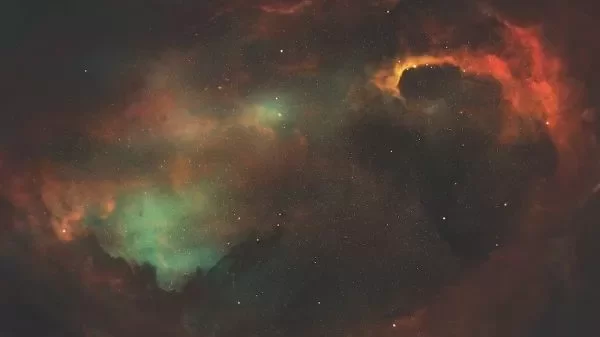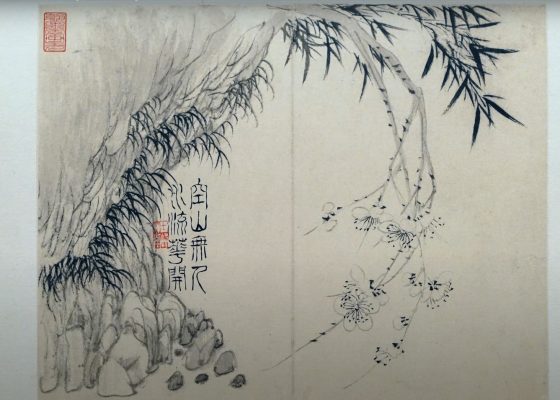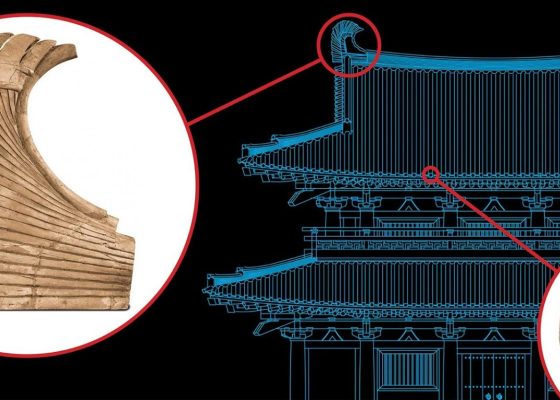
By All About Space magazine, Amanda Doyle
These cosmic creators, powered by dark matter, could be responsible for our existence, along with the appearance of today’s universe.
A star dies. A sudden flash of light signifies the end in a supernova explosion. This, however, is only part of the life cycle of stars, as the rich materials created during the death throes of the star are ejected into space by the supernova.
When the next generation of stars form, they sweep up the leftovers of the supernova, accreting the metals that the dying star produced — metals being the term that astronomers use for anything heavier than hydrogen and helium. Metals are important; without them, the disc of gas and dust surrounding a newly forming star could not create rocky planets. But if new stars recycle the metals produced in the deaths of old stars, what did the very first stars do?
The universe began with the Big Bang, which created the gases hydrogen and helium, trace amounts of lithium and perhaps beryllium as well. Matter began to clump together, pulling in ever more material through gravitational attraction. It may have been dark matter — the mysterious substance that has yet to be directly detected — that began to accumulate first. This then drew in the ordinary matter, the stuff we can see, such as hydrogen and helium. Together the dark and ordinary matter created what is known as a ‘minihalo’, although the name is somewhat misleading, as minihalos had masses around a million times that of our sun.

It was in the mini halos that the first stars were born 200 million years after the Big Bang.
The first stars are known as Population III stars, and none have ever been observed, as they are too faint. The first stars had to make do with what they had available, and formed from clouds containing only hydrogen and helium. When they died in supernovae explosions, they produced the first metals for the subsequent population of stars, Population II, which have a small proportion of metals. These went on to birth the metal-rich Population I stars we have today.
The dark matter in the minihalo may have done more than bring elements together — it might also have been present deep within the first stars. These stars are known as ‘dark stars’, due to the dark matter within them, although they would have actually shone very brightly.
Everything that we can see and detect — the stars and galaxies — only makes up a puny 5% of the universe, whereas dark matter comprises 25%. The rest is made of dark energy, another oddity thought to be responsible for accelerating the expansion of the universe. As CERN notes, dark matter does not interact with ordinary matter, and it does not produce any light. We only know that it must be there as its immense gravitational force tugs on ordinary matter.
One of the leading theories attempting to explain the invisible mass in the universe is a hypothetical particle known as a WIMP — a weakly interacting massive particle. ‘Weakly’ interacting refers to their relationship with ordinary matter. However, they would still interact with themselves. In fact, if two WIMPs collided with each other they would destroy each other in a process known as annihilation. This is because theories, such as this study at the University of Maryland, predict that WIMPs are their own ‘antiparticles’.

Dark matter first assembled into clumps and filaments before attracting ordinary matter to it and then forming the first stars. (Image credit: Tom Abel & Ralf Kaehler (KIPAC, SLAC), AMNH)
Ordinary matter has antiparticles, which are particles that have the same properties but are of opposite charge. Atoms consist of a nucleus surrounded by electrons. Electrons have a negative charge, and if they meet a particle known as a positron — with a positive charge — the electron and the positron will catastrophically annihilate each other.
A side effect of annihilation is that it produces energy. As a star begins to form in a minihalo, the collapsing material will contain hydrogen, helium, and WIMPs. At first the energy produced by the colliding WIMPs leaks out into space, but when the density of hydrogen is high enough, it traps the energy from the WIMPs inside the star. Even though the WIMPs only account for a tiny fraction of the mass of the star, they are so efficient at energy production that they can power a dark star for millions, or even billions of years.
It is still uncertain if all of the first stars were ordinary Population III stars with no dark matter, dark stars, or if both types of stars coexisted. “The standard scenario for the formation of the first stars does not rely on dark matter annihilation,” says Erik Zackrisson from Uppsala University in Sweden. “Dark stars are simply seen as an exotic alternative to the standard formation route.”
Ordinary stars are powered by fusion, the process that converts hydrogen into helium in the core of the star. The Population III stars would have been massive, weighing in at around 100 times the mass of our sun. However, they were also very hot, and this limited the amount of material that they could accrete. Dark stars, on the other hand, were much cooler. This meant that they could accrete substantially more of the surrounding material, and could theoretically keep growing as long as there was enough dark matter to fuel them, as NASA notes. Dark stars could have reached masses up to a million times that of the sun, with a luminosity a billion times brighter than it.

As the saying goes, all good things must come to an end, and the WIMPs will have eventually annihilated each other. Unlike Population III stars, which end their lives as supernovae, dark stars are so massive that they are fated to become a black hole. The smaller dark stars could take a detour on the way to oblivion by briefly igniting as an ordinary fusion-powered star. When this happened, the star would contract and become hotter. The hydrogen would have quickly been consumed in the belly of the star, and when the fusion engine could no longer support the star, the inevitable collapse into a black hole would have occurred.
The most massive of the dark stars would have bypassed the fusion stage altogether, collapsing straight into a black hole. These black holes were so massive that they offer a solution to a problem that had previously puzzled scientists. Supermassive black holes, which can be billions of solar masses, exist at the center of every galaxy, and are known to have existed only a billion years after the Big Bang. However, an ordinary star collapsing into a black hole would need more than a few hundred million years to gobble up enough material to become a supermassive black hole. “Ordinary stars cannot do it, because ordinary stars are too small,” explains Katherine Freese from the University of Texas at Austin. “Dark stars, on the other hand, can grow to become a million times as massive as the sun, and then when they run out of fuel they collapse into million-solar-mass black holes, the perfect seeds for monstrous supermassive black holes.”

The supermassive WIMP-powered dark stars could only have formed in the minihalos of the early universe, when the density of dark matter was much higher than it is today. Over time, as the universe expanded, everything became more spread out, so there are no longer minihalos capable of birthing supermassive dark stars.
This confines them to the early universe, which also means that they are at a great distance from us here on Earth. Astronomers use the term ‘redshift’ to denote distance in cosmology, as the light from a distant object will get shifted towards the red end of the spectrum, permitted that it’s moving away from us. Dark stars only exist at high redshifts, making them an observing challenge. The infrared Ultra Deep Field images taken by Hubble were used to look for dark stars, but none were found. This doesn’t necessarily mean they don’t exist, as there could be less luminous dark stars lurking beyond Hubble’s vision. The upcoming James Webb Space Telescope (JWST) — due to be launched in October 2021 — will outdo its predecessor by looking further back in time.
“If dark stars do exist, and are sufficiently massive, numerous and long-lived, then the JWST certainly has a decent chance of confirming their existence at high redshifts,” says Zackrisson. “However, since the distribution of dark star properties hinges on both the properties of the dark matter particles and the cosmological evolution of the dark matter halos that host them, success is by no means guaranteed.”
Even if the JWST can’t detect individual dark stars, it might still be able to detect their overall glow. Just as individual street lights all add up to produce an infuriating yellow glow over cities, light from stars and galaxies accumulates into what is known as the extragalactic background light (EBL). The EBL has already been mapped to a certain extent, but the improved measurements from the JWST will help to sniff out the contributions from dark stars, which hasn’t been manageable before.

While WIMP annihilation can theoretically provide enough fuel to keep a dark star going for billions of years, it is unlikely that any of the dark stars from the early universe are still around today. However, it is possible that a new generation of dark stars could exist where dark matter concentrations are still somewhat high, such as in the centre of galaxies. As there is less dark matter in galactic centers compared to the minihalos of the ancient universe, the new generation of dark stars would be much less massive—only equivalent to that of our sun—and will never be able to rival the glory days of the first stars.
Solar-mass dark stars near the galactic center would not have formed while trapping WIMPs inside them, but rather by capturing some of the dark matter that resides at the center of the galaxy. When this happens, dark matter heating takes over from ordinary fusion, and the stars cool and expand. Not only would this make them appear younger than they actually are, but it could also extend their lifetimes exponentially. If there was enough dark matter for them to continuously accrete it, the dark stars could exist indefinitely. Everlasting dark stars could bookend the lives of some stars in the universe.
Another possibility is that ‘dead’ stars such as neutron stars or white dwarfs at the galactic center could gather enough WIMPs in order to trigger dark matter heating, as noted in a study at Queen’s University in Kingston, Ontario. These stars would otherwise become fainter over time, but with a new heating source they would get a new lease of life, and appear strangely younger and hotter than expected.
Understanding the early years of our wondrous universe and how the first stars came to be is crucial to understanding what we see around us today, as well as understanding the more complex objects and phenomenons in the solar system. It is a murky period that is difficult to observe, but with the next generation of telescopes, such as the JWST, it might finally be possible to detect both the supermassive dark stars of the early universe and their less impressive cousins in the galactic center.
Discovering whether it was Population III stars, dark stars, or both that were the first stars to form in the universe will have a profound effect on cosmology. It won’t be long before we can shed some light on these dark members of the cosmos.











Cancel anytime


Using our website
You may use the The Middle Land website subject to the Terms and Conditions set out on this page. Visit this page regularly to check the latest Terms and Conditions. Access and use of this site constitutes your acceptance of the Terms and Conditions in-force at the time of use.
Intellectual property
Names, images and logos displayed on this site that identify The Middle Land are the intellectual property of New San Cai Inc. Copying any of this material is not permitted without prior written approval from the owner of the relevant intellectual property rights.
Requests for such approval should be directed to the competition committee.
Please provide details of your intended use of the relevant material and include your contact details including name, address, telephone number, fax number and email.
Linking policy
You do not have to ask permission to link directly to pages hosted on this website. However, we do not permit our pages to be loaded directly into frames on your website. Our pages must load into the user’s entire window.
The Middle Land is not responsible for the contents or reliability of any site to which it is hyperlinked and does not necessarily endorse the views expressed within them. Linking to or from this site should not be taken as endorsement of any kind. We cannot guarantee that these links will work all the time and have no control over the availability of the linked pages.
Submissions
All information, data, text, graphics or any other materials whatsoever uploaded or transmitted by you is your sole responsibility. This means that you are entirely responsible for all content you upload, post, email or otherwise transmit to the The Middle Land website.
Virus protection
We make every effort to check and test material at all stages of production. It is always recommended to run an anti-virus program on all material downloaded from the Internet. We cannot accept any responsibility for any loss, disruption or damage to your data or computer system, which may occur while using material derived from this website.
Disclaimer
The website is provided ‘as is’, without any representation or endorsement made, and without warranty of any kind whether express or implied.
Your use of any information or materials on this website is entirely at your own risk, for which we shall not be liable. It is your responsibility to ensure any products, services or information available through this website meet your specific requirements.
We do not warrant the operation of this site will be uninterrupted or error free, that defects will be corrected, or that this site or the server that makes it available are free of viruses or represent the full functionality, accuracy and reliability of the materials. In no event will we be liable for any loss or damage including, without limitation, loss of profits, indirect or consequential loss or damage, or any loss or damages whatsoever arising from the use, or loss of data, arising out of – or in connection with – the use of this website.
Last Updated: September 11, 2024
New San Cai Inc. (hereinafter “The Middle Land,” “we,” “us,” or “our”) owns and operates www.themiddleland.com, its affiliated websites and applications (our “Sites”), and provides related products, services, newsletters, and other offerings (together with the Sites, our “Services”) to art lovers and visitors around the world.
This Privacy Policy (the “Policy”) is intended to provide you with information on how we collect, use, and share your personal data. We process personal data from visitors of our Sites, users of our Services, readers or bloggers (collectively, “you” or “your”). Personal data is any information about you. This Policy also describes your choices regarding use, access, and correction of your personal information.
If after reading this Policy you have additional questions or would like further information, please email at middleland@protonmail.com.
PERSONAL DATA WE COLLECT AND HOW WE USE IT
We collect and process personal data only for lawful reasons, such as our legitimate business interests, your consent, or to fulfill our legal or contractual obligations.
Information You Provide to Us
Most of the information Join Talents collects is provided by you voluntarily while using our Services. We do not request highly sensitive data, such as health or medical information, racial or ethnic origin, political opinions, religious or philosophical beliefs, trade union membership, etc. and we ask that you refrain from sending us any such information.
Here are the types of personal data that you voluntarily provide to us:
As a registered users or customers, you may ask us to review or retrieve emails sent to your business. We will access these emails to provide these services for you.
We use the personal data you provide to us for the following business purposes:
Information Obtained from Third-Party Sources
We collect and publish biographical and other information about users, which we use to promote the articles and our bloggers who use our sites. If you provide personal information about others, or if others give us your information, we will only use that information for the specific reason for which it was provided.
Information We Collect by Automated Means
Log Files
The site uses your IP address to help diagnose server problems, and to administer our website. We use your IP addresses to analyze trends and gather broad demographic information for aggregate use.
Every time you access our Site, some data is temporarily stored and processed in a log file, such as your IP addresses, the browser types, the operating systems, the recalled page, or the date and time of the recall. This data is only evaluated for statistical purposes, such as to help us diagnose problems with our servers, to administer our sites, or to improve our Services.
Do Not Track
Your browser or device may include “Do Not Track” functionality. Our information collection and disclosure practices, and the choices that we provide to customers, will continue to operate as described in this Privacy Policy, whether or not a “Do Not Track” signal is received.
HOW WE SHARE YOUR INFORMATION
We may share your personal data with third parties only in the ways that are described in this Privacy Policy. We do not sell, rent, or lease your personal data to third parties, and We does not transfer your personal data to third parties for their direct marketing purposes.
We may share your personal data with third parties as follows:
There may be other instances where we share your personal data with third parties based on your consent.
HOW WE STORE AND SECURE YOUR INFORMATION
We retain your information for as long as your account is active or as needed to provide you Services. If you wish to cancel your account, please contact us middleland@protonmail.com. We will retain and use your personal data as necessary to comply with legal obligations, resolve disputes, and enforce our agreements.
All you and our data are stored in the server in the United States, we do not sales or transfer your personal data to the third party. All information you provide is stored on a secure server, and we generally accepted industry standards to protect the personal data we process both during transmission and once received.
YOUR RIGHTS/OPT OUT
You may correct, update, amend, delete/remove, or deactivate your account and personal data by making the change on your Blog on www.themiddleland.com or by emailing middleland@protonmail.com. We will respond to your request within a reasonable timeframe.
You may choose to stop receiving Join Talents newsletters or marketing emails at any time by following the unsubscribe instructions included in those communications, or you can email us at middleland@protonmail.com
LINKS TO OTHER WEBSITES
The Middle Land include links to other websites whose privacy practices may differ from that of ours. If you submit personal data to any of those sites, your information is governed by their privacy statements. We encourage you to carefully read the Privacy Policy of any website you visit.
NOTE TO PARENTS OR GUARDIANS
Our Services are not intended for use by children, and we do not knowingly or intentionally solicit data from or market to children under the age of 18. We reserve the right to delete the child’s information and the child’s registration on the Sites.
PRIVACY POLICY CHANGES
We may update this Privacy Policy to reflect changes to our personal data processing practices. If any material changes are made, we will notify you on the Sites prior to the change becoming effective. You are encouraged to periodically review this Policy.
HOW TO CONTACT US
If you have any questions about our Privacy Policy, please email middleland@protonmail.com
The Michelin brothers created the guide, which included information like maps, car mechanics listings, hotels and petrol stations across France to spur demand.
The guide began to award stars to fine dining restaurants in 1926.
At first, they offered just one star, the concept was expanded in 1931 to include one, two and three stars. One star establishments represent a “very good restaurant in its category”. Two honour “excellent cooking, worth a detour” and three reward “exceptional cuisine, worth a
Thank you for your participation,
please Log in or Sign up to Vote

123Sign in to your account